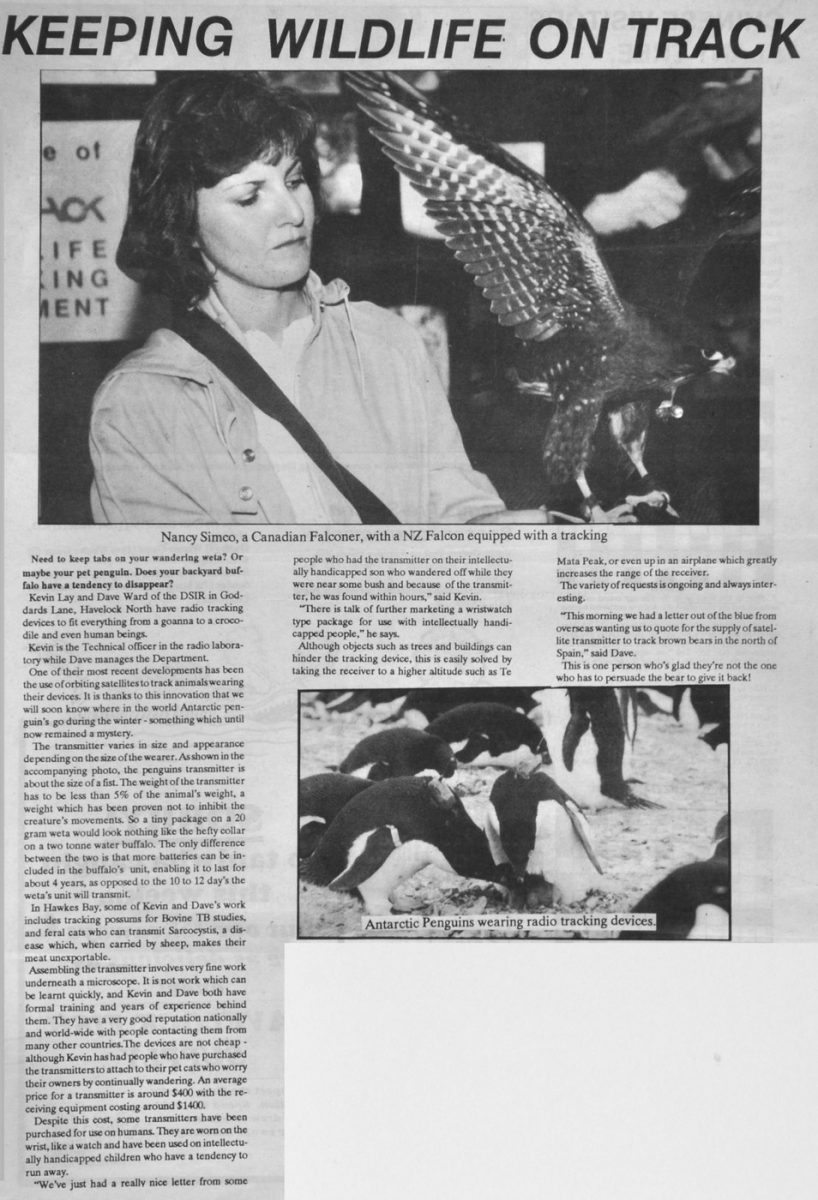KEEPING WILDLIFE ON TRACK
Need to keep tabs on your wandering weta? Or maybe your pet penguin. Does your backyard buffalo have a tendency to disappear?
Kevin Lay and Dave Ward of the DSIR in Goddards Lane, Havelock North have radio tracking devices to fit everything from a goanna to a crocodile and even human beings.
Kevin is the Technical officer in the radio laboratory while Dave manages the Department.
One of their most recent developments has been the use of orbiting satellites to track animals wearing their devices. It is thanks to this innovation that we will soon know where in the world Antarctic penguin’s go during the winter – something which until now remained a mystery.
The transmitter varies in size and appearance depending on the size of the wearer. As shown in the accompanying photo, the penguins transmitter is about the size of a fist. The weight of the transmitter has to be less than 5% of the animal’s weight, a weight which has been proven not to inhibit the creature’s movements. So a tiny package on a 20 gram weta would look nothing like the hefty collar on a two tonne water buffalo. The only difference between the two is that more batteries can be included in the buffalo’s unit, enabling it to last for about 4 years, as opposed to the 10 to 12 day’s the weta’s unit will transmit.
In Hawkes Bay, some of Kevin and Dave’s work includes tracking possums for Bovine TB studies, and feral cats who can transmit Sarcocystis, a disease which, when carried by sheep, makes their meat unexportable.
Assembling the transmitter involves very fine work underneath a microscope. it is not work which can be learnt quickly, and Kevin and Dave both have formal training and years of experience behind them. They have a very good reputation nationally and world-wide with people contacting them from many other countries. The devices are not cheap – although Kevin has had people who have purchased the transmitters to attach to their pet cats who worry their owners by continually wandering. An average price for a transmitter is around $400 with the receiving equipment costing around $1400.
Despite this cost, some transmitters have been purchased for use on humans They are worn on the wrist like a watch and have been used on intellectually handicapped children who have a tendency to run away.
“We’ve just had a really nice letter from some people who had the transmitter on their intellectually handicapped son who wandered off while they were near some bush and because of the transmitter, he was found within hours.” said Kevin.
“There is talk of further marketing a wristwatch type package for use with intellectually handicapped people.” he says.
Although objects such as trees and buildings can hinder the tracking device, this is easily solved by taking the receiver to a higher altitude such as Te Mata Peak, or even up in an airplane which greatly increases the range of the receiver.
The variety of requests is ongoing and always interesting.
“This morning we had a letter out of the blue from overseas wanting us to quote for the supply of satellite transmitter to track brown bears in the north of Spain,” said Dave.
This is one person who’s glad they’re not the one who has to persuade the bear to give it back!
Photo caption – Antarctic Penguins wearing radio tracking devices.












Do you know something about this record?
Please note we cannot verify the accuracy of any information posted by the community.